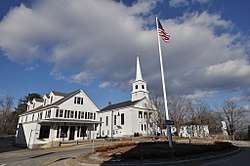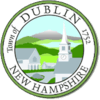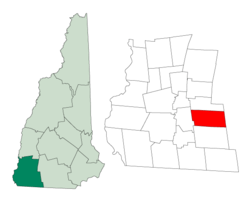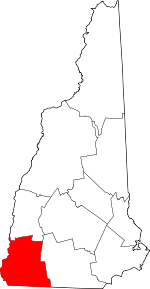Dublin, New Hampshire
Dublin is a town in Cheshire County, New Hampshire, United States. The population was 1,597 at the 2010 census.[1] It is home to Dublin School and Yankee magazine is based there.
Dublin, New Hampshire | |
|---|---|
Town | |
 Church and rotary in the town center | |
 Seal | |
 Location in Cheshire County, New Hampshire | |
| Coordinates: 42°54′21″N 72°03′39″W | |
| Country | United States |
| State | New Hampshire |
| County | Cheshire |
| Incorporated | 1771 |
| Government | |
| • Board of Selectmen | Walter Snitko, Chair Chris Raymond Carole Monroe |
| • Town Administrator | Kate Fuller |
| Area | |
| • Total | 29.1 sq mi (75.3 km2) |
| • Land | 28.0 sq mi (72.5 km2) |
| • Water | 1.1 sq mi (2.8 km2) 3.78% |
| Elevation | 1,440 ft (439 m) |
| Population (2010) | |
| • Total | 1,597 |
| • Density | 55/sq mi (21/km2) |
| Time zone | UTC-5 (Eastern) |
| • Summer (DST) | UTC-4 (Eastern) |
| ZIP code | 03444 |
| Area code(s) | 603 |
| FIPS code | 33-19140 |
| GNIS feature ID | 0873581 |
| Website | www |
History

In 1749, the Masonian proprietors granted the town as Monadnock No. 3 (or North Monadnock) to Matthew Thornton and 39 others. The 40 grantees came mostly from middle and eastern parts of New Hampshire; none of them grantees became settlers in the township. The deed of grant, which dated November 3, 1749, was given by Col. Joseph Blanchard of Dunstable.[2]
The French and Indian War thwarted permanent settlement until the 1760s, when Henry Strongman moved from Peterborough. Other early settlers arrived from Sherborn, Massachusetts. In 1771, Governor John Wentworth incorporated the town, naming it after Strongman's birthplace: Dublin, Ireland.[3]
Like all towns in this area, the terrain features hills and valleys. Farmers found the soil hard and rocky, but with effort it yielded maize, oats, barley and potatoes, with some wheat and rye. Orchards were common. The first census, taken in 1790, reported 901 residents.[4] By 1859, there were 1,088.[3] In 1870, the small mill town of Harrisville voted to separate from Dublin, leaving the latter with only 455 residents during the 1880 census.[5]
Geography
According to the United States Census Bureau, the town has a total area of 29.1 square miles (75 km2), of which 28.0 sq mi (73 km2) are land and 1.1 sq mi (2.8 km2) are water, comprising 3.78% of the town. The northern slopes of Mount Monadnock occupy the southern part of town. The highest point in Dublin is along Monadnock's northeast ridge, where the elevation reaches 2,834 feet (864 m) above sea level at the town line. Roughly the western half of Dublin lies within the Connecticut River watershed, drained by tributaries of the Ashuelot River, with the eastern half located in the Merrimack River watershed, drained by tributaries of the Contoocook River.[6]
The ponds in Dublin include Monadnock Lake (now known as Dublin Pond), Farnum (Dark) Pond, and Wight Pond, as well as Howe, Knight, and Electric Company Reservoirs.[2]
Dublin Pond is a clean sheet of water that has brought many families of wealth to the area. It is surrounded by a vast area of woods leading to the edge of the summit of Mount Monadnock, and from its surface the summit and northwest sides of the mountain. At the right hour on the right kind of day, the mountain is clearly reflected upon the surface of the pond.[2]
The town is crossed by New Hampshire Route 101 and New Hampshire Route 137. NH 101 leads east 6 miles (10 km) to Peterborough and west 8 miles (13 km) to Marlborough and 13 miles (21 km) to Keene. NH 137 leads north 7 miles (11 km) to Hancock and south 6 miles (10 km) to Jaffrey.
Adjacent municipalities
- Harrisville (north)
- Peterborough (east)
- Jaffrey (south)
- Marlborough (west)
Architecture
The history of Dublin's architecture starts with the foundation of the United States, and the development of the Federal style of architecture. The style in Dublin can be attributed to one Rufus Piper, who served as the town moderator and was a carpenter at the time. Piper was responsible for adding fans to various houses in the town, which included his own home and his grandfather's house.[7]
Demographics
| Historical population | |||
|---|---|---|---|
| Census | Pop. | %± | |
| 1790 | 901 | — | |
| 1800 | 1,188 | 31.9% | |
| 1810 | 1,184 | −0.3% | |
| 1820 | 1,620 | 36.8% | |
| 1830 | 1,218 | −24.8% | |
| 1840 | 1,075 | −11.7% | |
| 1850 | 1,088 | 1.2% | |
| 1860 | 1,096 | 0.7% | |
| 1870 | 930 | −15.1% | |
| 1880 | 456 | −51.0% | |
| 1890 | 582 | 27.6% | |
| 1900 | 620 | 6.5% | |
| 1910 | 571 | −7.9% | |
| 1920 | 408 | −28.5% | |
| 1930 | 506 | 24.0% | |
| 1940 | 621 | 22.7% | |
| 1950 | 675 | 8.7% | |
| 1960 | 684 | 1.3% | |
| 1970 | 837 | 22.4% | |
| 1980 | 1,303 | 55.7% | |
| 1990 | 1,474 | 13.1% | |
| 2000 | 1,476 | 0.1% | |
| 2010 | 1,597 | 8.2% | |
| Est. 2017 | 1,538 | [8] | −3.7% |
| U.S. Decennial Census[9] | |||
At the 2000 census,[10] there were 1,476 people, 560 households and 417 families residing in the town. The population density was 52.7 per square mile (20.4/km2). There were 686 housing units at an average density of 24.5 per square mile (9.5/km2). The racial makeup of the town was 97.29% White, 0.34% African American, 0.54% Native American, 0.95% Asian, 0.41% from other races, and 0.47% from two or more races. Hispanic or Latino of any race were 1.15% of the population.
There were 560 households of which 32.5% had children under the age of 18 living with them, 65.4% were married couples living together, 6.6% had a female householder with no husband present, and 25.4% were non-families. 21.1% of all households were made up of individuals and 6.6% had someone living alone who was 65 years of age or older. The average household size was 2.51 and the average family size was 2.89.
23.4% of the population were under the age of 18, 5.9% from 18 to 24, 25.0% from 25 to 44, 32.5% from 45 to 64, and 13.2% who were 65 years of age or older. The median age was 43 years. For every 100 females, there were 101.1 males. For every 100 females age 18 and over, there were 99.5 males.
The median household income was $52,150 and the median income for a family was $57,578. Males had a median income of $36,853 compared with $25,859 for females. The per capita income was $27,028. About 6.0% of families and 10.6% of the population were below the poverty line, including 16.8% of those under age 18 and 5.0% of those age 65 or over.
Economy
Dublin is the base for Yankee Publishing Inc., the publisher of the Old Farmer's Almanac and Yankee magazine.
Education
- Dublin School, a coeducational private boarding school, founded in 1935 by Paul W. Lehmann
- The Walden School, a summer music camp on the campus of Dublin School
- Dublin Christian Academy, founded in 1963
Current events
2019 is the 48th year for the Dublin Gas Engine Meet on Cricket Hill Farm, which is the longest lasting tradition in Dublin after Town Meeting. Every year, the town prepares starting in October for the Halloween events around town that occur each year.[11]
See also
- Dublin Pond
- Irish place names in other countries
Notable people
- Galen Clark, nature activist
- Grenville Clark, lawyer
- Doris Haddock, political activist
- Moses Mason, Jr., physician and US congressman
- William Preston Phelps, artist
- Abbott Handerson Thayer, artist
- Mark Twain, author (summer resident, two years)[5]
References
- United States Census Bureau, American FactFinder, 2010 Census figures. Retrieved March 23, 2011.
- Dublin (N.H.) (1920). The History of Dublin, N.H.: Containing the Address by Charles Mason, and the Proceedings at the Centennial Celebration, June 17, 1852, with a Register of Families. Town of Dublin.
- Coolidge, Austin J.; John B. Mansfield (1859). A History and Description of New England. Boston, Massachusetts: A.J. Coolidge. pp. 474–477.
coolidge mansfield history description new england 1859.
- New Hampshire Economic and Labor Market Information Bureau Profile -- Dublin, New Hampshire Archived May 22, 2011, at the Wayback Machine
- "About the Town of Dublin". Town of Dublin, New Hampshire. Retrieved 2008-12-23.
- Foster, Debra H.; Batorfalvy, Tatianna N.; Medalie, Laura (1995). Water Use in New Hampshire: An Activities Guide for Teachers. U.S. Department of the Interior and U.S. Geological Survey.
- Morgan, William (2011). Monadnock Summer: The Architectural Legacy of Dublin, New Hampshire. David R. Godine Publisher. ISBN 9781567924220.
- "Annual Estimates of the Resident Population: April 1, 2010 to July 1, 2017 (PEPANNRES): Minor Civil Divisions – New Hampshire". Archived from the original on February 13, 2020. Retrieved November 14, 2018.
- "Census of Population and Housing". Census.gov. Retrieved June 4, 2016.
- "U.S. Census website". United States Census Bureau. Retrieved 2008-01-31.
- "The Dublin Advocate – To Encourage and Strengthen Our Community". Retrieved 2019-10-31.
